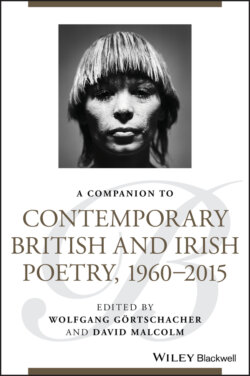Читать книгу A Companion to Contemporary British and Irish Poetry, 1960 - 2015 - Группа авторов - Страница 15
Philip Larkin, “An Arundel Tomb” (1964) (Larkin 1964, 45–46)
ОглавлениеThe title of this poem is immediately striking. Why the indefinite article? Is it one tomb among many? Are there other examples of such tombs, with the meanings added by the poem? Further, the title refers to a documented monument, and the text itself offers an accurate description of it, except for the assertion that “little dogs” lie at the feet of the couple. A dog lies at the feet of the woman, a lion at the feet of the man.
The subject matter is clearly and rationally set forth over seven stanzas of the same length: the tomb is described (stanzas 1 and 2); the speaker's response and direct reflection are given (stanzas 2–5); general reflection on time, change, and endurance follows (stanzas 6–7). An act of observation and reflection on the part of the speaker is recorded, but that act is consistently impersonal (line 8: “the eye”; line 11: “one sees”; line 42: “us”). Order and consistency are embodied in technical aspects of the text. Each stanza contains six lines. All lines are eight syllables in length. The rhyme scheme is largely consistent (abbcac). Iambs and diambs dominate in the poem. All such features are appropriate in a text that celebrates traditional married love, unity in death, and the survival of a feudal and aristocratic past.
However, this poem is also a technically disordered piece. For example, while iambs and diambs dominate stanza 1, several other feet are prominent (amphibrachs and amphimacers). Lines 5 and 6 both end in four beat feet that can only be construed as diambs with some difficulty, and are best understood as fourth paeons (xxx/). In addition, foot divisions are uncertain at the ends of lines 2, 3, and 4. Are these amphimacers or in line 2 a single‐stress foot followed by an iamb, and in lines 3 and 4 trochees followed by single‐stressed feet? In a poem about unity, isolated single stresses carry a contestatory semantic weight, while in a poem about tradition and order, metrical irresolution is surely disruptive. In fact, several lines can only be scanned as iambic if the reader places the values of the metronome over natural speech, for example, stanza 3, line 5 and stanza 7, line 5. Further, the first lines of stanzas 6 and 7 both contain metrically monstrous feet: “at their identity” (xxx/xx) and “has transfigured them into” (xx/xxxx)—although other scansions are possible.
Further disorder can be seen in phonological patterning, which in this poem is always local, and in a rhyme scheme that does fracture on occasion, for example, the anisobaric rhymes in lines 10 and 12, and in lines 14 and 15. This is particularly clear in the last, seemingly triumphant stanza: lines 37 and 41 (“into / true”) and lines 38 and 39 (“fidelity / to be”). It is surely important that the concluding “love” does not actually rhyme fully with the preceding “prove.” In addition, in a poem celebrating unity, the persistent recurrence of enjambment (11 examples, plus the radical enjambment between stanzas 4 and 5) must disturb. One can also notice a further degree of uncertainty in the poem's puns: inter alia “proper habits” (line 3), “faithfulness in effigy” (line 14), and “blazon” (line 40). Paronomasia disrupts as much as enjambment: things are not what they seem.
Attention to technique reveals a much more ambiguous poem than a superficial reading brings. “Untruth” and disorder become as important as the survival of tradition and “love.” What appears as a celebration of tradition becomes something much more questioning and fragmentary. Are there other such monuments, English history incarnate, seemingly solid and unambiguous, that reveal themselves as complex and ambiguous?
